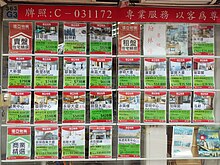This article provides insufficient context for those unfamiliar with the subject. (August 2023) |

In housing economics, filtering is the process by which a housing unit becomes more affordable with age. In markets with sufficient housing supply, homes will command the highest prices and rents when brand new, and depreciate over time as they get older. Thus new constructions will tend to be occupied by higher-income groups at first, but successively filter (become accessible) to lower-income groups.[1]
Importantly, filtering depends upon sufficient supply[2] (either from new construction in a growing area, or depopulation — see Housing in Japan). In markets with insufficient housing supply, reverse or upward filtering can occur. This is when units once occupied by lower-income residents quickly appreciate and become occupied by higher-income residents (see also gentrification).[1] As a consequence, increased supply in new market-rate housing (which tends to be occupied by higher-income individuals) is associated with increased housing affordability for lower-income individuals, as higher-income individuals vacate old housing or stop competing for old housing.[3]
- ^ a b Sayegh, Kamal S. (1987). Housing: A Multidisciplinary Dictionary (1 ed.). Ottawa: ABCD-Academy Book. pp. 189, 215. ISBN 0-921139-01-2.
- ^ Cite error: The named reference
myerswas invoked but never defined (see the help page). - ^ Mast, Evan (2023). "JUE Insight: The effect of new market-rate housing construction on the low-income housing market". Journal of Urban Economics. 133: 103383. doi:10.1016/j.jue.2021.103383. ISSN 0094-1190.